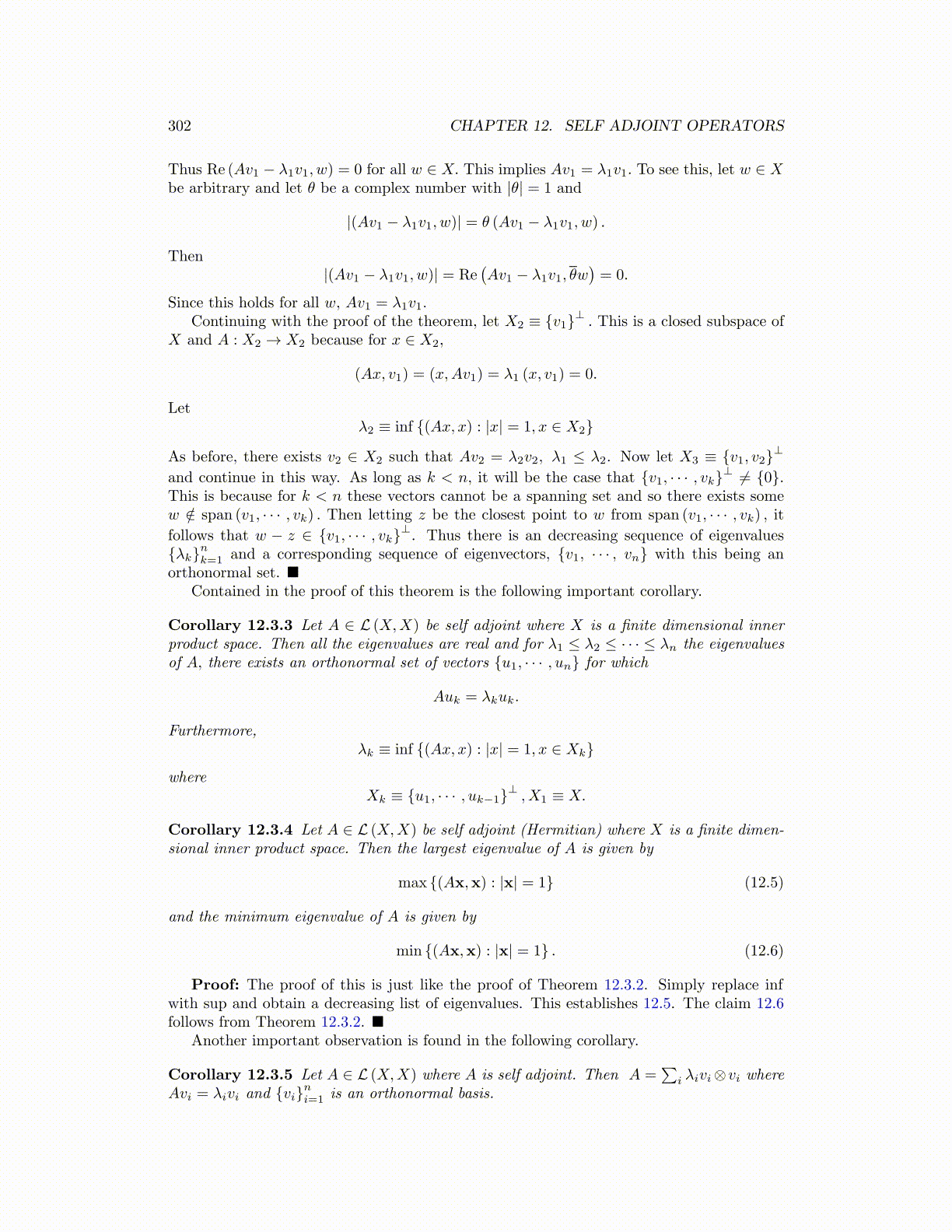
302 CHAPTER 12. SELF ADJOINT OPERATORS
Thus Re (Av1 − λ1v1, w) = 0 for all w ∈ X. This implies Av1 = λ1v1. To see this, let w ∈ Xbe arbitrary and let θ be a complex number with |θ| = 1 and
|(Av1 − λ1v1, w)| = θ (Av1 − λ1v1, w) .
Then|(Av1 − λ1v1, w)| = Re
(Av1 − λ1v1, θw
)= 0.
Since this holds for all w, Av1 = λ1v1.Continuing with the proof of the theorem, let X2 ≡ {v1}⊥ . This is a closed subspace of
X and A : X2 → X2 because for x ∈ X2,
(Ax, v1) = (x,Av1) = λ1 (x, v1) = 0.
Letλ2 ≡ inf {(Ax, x) : |x| = 1, x ∈ X2}
As before, there exists v2 ∈ X2 such that Av2 = λ2v2, λ1 ≤ λ2. Now let X3 ≡ {v1, v2}⊥
and continue in this way. As long as k < n, it will be the case that {v1, · · · , vk}⊥ ̸= {0}.This is because for k < n these vectors cannot be a spanning set and so there exists somew /∈ span (v1, · · · , vk) . Then letting z be the closest point to w from span (v1, · · · , vk) , itfollows that w − z ∈ {v1, · · · , vk}⊥. Thus there is an decreasing sequence of eigenvalues{λk}nk=1 and a corresponding sequence of eigenvectors, {v1, · · · , vn} with this being anorthonormal set. ■
Contained in the proof of this theorem is the following important corollary.
Corollary 12.3.3 Let A ∈ L (X,X) be self adjoint where X is a finite dimensional innerproduct space. Then all the eigenvalues are real and for λ1 ≤ λ2 ≤ · · · ≤ λn the eigenvaluesof A, there exists an orthonormal set of vectors {u1, · · · , un} for which
Auk = λkuk.
Furthermore,λk ≡ inf {(Ax, x) : |x| = 1, x ∈ Xk}
whereXk ≡ {u1, · · · , uk−1}⊥ , X1 ≡ X.
Corollary 12.3.4 Let A ∈ L (X,X) be self adjoint (Hermitian) where X is a finite dimen-sional inner product space. Then the largest eigenvalue of A is given by
max {(Ax,x) : |x| = 1} (12.5)
and the minimum eigenvalue of A is given by
min {(Ax,x) : |x| = 1} . (12.6)
Proof: The proof of this is just like the proof of Theorem 12.3.2. Simply replace infwith sup and obtain a decreasing list of eigenvalues. This establishes 12.5. The claim 12.6follows from Theorem 12.3.2. ■
Another important observation is found in the following corollary.
Corollary 12.3.5 Let A ∈ L (X,X) where A is self adjoint. Then A =∑
i λivi⊗vi whereAvi = λivi and {vi}ni=1 is an orthonormal basis.